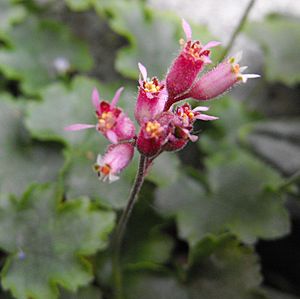San Gabriel alumroot facts for kids
Quick facts for kids San Gabriel alumroot |
|
|---|---|
 |
|
| Scientific classification | |
| Genus: |
Heuchera
|
| Species: |
abramsii
|
Heuchera abramsii, also known as the San Gabriel alumroot or Abrams' alumroot, is a special and rare flowering plant. It belongs to the saxifrage family. This beautiful plant grows only in a specific part of southern California.
Contents
Discovering the San Gabriel Alumroot
Where Does It Live?
The San Gabriel alumroot is a plant that is endemic to the San Gabriel Mountains. This means it naturally grows only in this mountain range. You can find it on rocky slopes in the mountains of southern California. It is a unique part of the natural world in places like the Angeles National Forest.
What Does It Look Like?
The San Gabriel alumroot is a type of plant called a perennial herb. This means it lives for more than two years and does not have a woody stem like a tree. It grows from a rhizome, which is an underground stem. This helps the plant spread and grow new shoots.
The plant has small leaves with five lobes, which means they have five rounded sections. It also grows a tall flower stalk, called an inflorescence. This stalk can reach up to 15 centimeters (about 6 inches) high. On top of the stalk, you will see many bright pink or magenta flowers. These flowers are rounded and shaped like tiny bells.
Why Is It Special?
The San Gabriel alumroot is considered a rare species. This means there are not many of these plants left in the wild. Its special status makes it an important plant to protect. It is a unique part of the San Gabriel Mountains ecosystem.
How Did It Get Its Name?
The second part of the plant's scientific name, abramsii, is called an epithet. This part of the name honors a person. In this case, it commemorates a botanist named LeRoy Abrams. He was a famous plant scientist. Naming plants after people is a way to remember their contributions to science.

